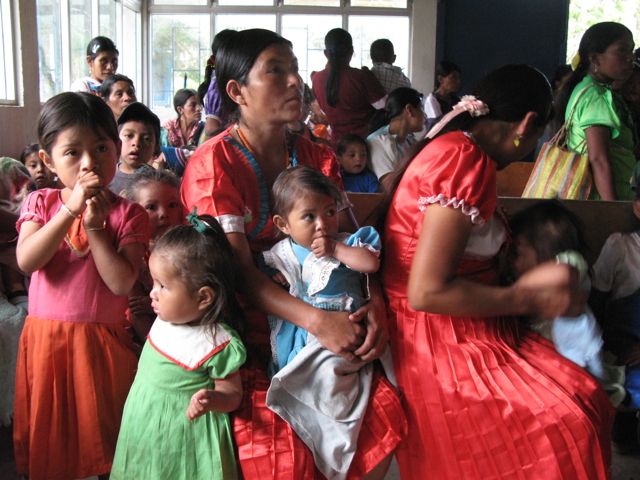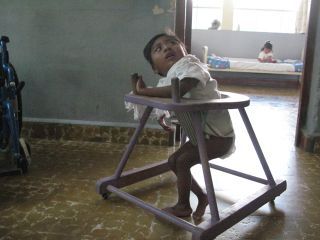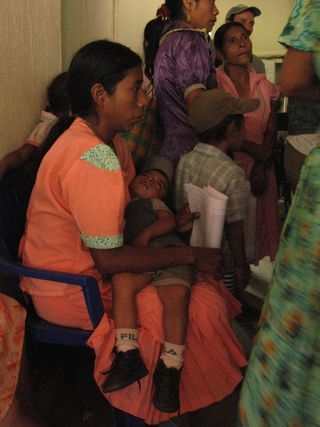The little girl does not smile. She doesn't have the energy. Hopefully she will soon.
She is in a rehabilitation clinic in Jocotan, Chiquimula, a province in the far east of Guatemala, near to Honduras. Her name is Domitila, she is nine years old. Her body is emaciated, she is fragile. Patches of her hair are missing, the veins in her legs show through her skin. Her face has a perpetual look of sorrow – the muscles are too weak to change expression. Other children in her family were in similar shape, the nurse tells me.
A boy, Israel, can not even support himself. He has been placed in a walker, where he lays sprawled. When he sees me, he tries several times to raise himself, but he cannot muster it. A pair of babies, twins, are so thin and frail I can hardly stand to look at them.
These were the lucky ones that were being taken care of in the well-staffed and clean Bethania clinic.
The cases of Israel, Domitila, and the other children here are the extreme edge of what is in fact an all-too common problem in Guatemala: childhood malnutrition. While these children in the clinic faced the possibility of starvation, the more common problem is not a lack of food itself, but a lack of the right kind of food, with enough vitamins and micronutrients to keep children healthy. Children who suffer from chronic malnutrition are not in immediate danger of starvation, but they will face stunted growth and a diminished mental capacity. Th children don't look underweight, they just look tiny. Some have light hair, a sign of vitamin deficiency, others are missing patches of hair, like Domitila.
Half the children in Guatemala suffer from this type of food poverty, known as chronic malnutrition. In some areas it is as high as 75 percent, which is among the highest such rates in the world.
The populations affected are largely the indigenous Mayan communities that make up most of the country's rural poor. The hunger hotspots also track with the places the civil war was most fierce, like the province of Quiche in the highlands. This was not by mistake. "Budgets were shifted to keep some populations less developed," said Andres Botran, who pioneered some of his country's anti-hunger programs in the last government. "For us it is a national shame."
It is often said that Guatemala is really two countries in one, divided between the few rich and the many poor. This is only partly true. One would not exist without the other. It is among the most unequal countries in the entire world, with 20 percent of the population receiving 60 percent of the income.
Botran himself is one of Guatemala's ruling elite, the scion of the powerful rum dynasty that bears his name. It was Botran who took up the issue in the early part of his the decade as an adviser to the Berger government, which was more conservative than the current one although far from the hard-line military forces in some parties. Botran admits that he came across the issue almost by mistake, as a political maneuver while staying with friends in Georgetown. He says that when his assistant first presented him with data that half his country's children were malnourished, he did not believe it and accused him of making a mistake. But the numbers were right.
The reasons for chronic malnutrition in Guatemala are attributable to a number of factors: a lack of education; the increased price of beans, one of the only sources of protein for villagers; poor or in some cases non-existent infrastructure, meaning no electricity or running water, and certainly no clean water: so diarrhea is a major factor. And Guatemala remains a highly dysfunctional society, still badly damaged by the 36-year-old civil war and income inequality that is some of the worst in the world.
Underlying all of it is poverty.
The malnutrition, which is hidden from Guatemala's wealthy urban populace, happens in places like the mountain village I visited in the Northern Highlands near to the town of Santa Cruz del Quiche. There, huts with dirt floors and tin roofs with little patches of land out back growing corn or lettuce or chili peppers. It is lunchtime, and inside one two-room hut a mother was feeding her five children. She worked over a wood fired stove, rhythmically patting her hands making dozens of tortillas, to accompany a small bowl of pasta and just a spoonful of frijoles. Her youngest daughter is being treated for malnourishment, and the other children appeared to be stunted as well. They wolf down their tortillas and drink a Kool-aid like mixture to fill their stomachs.
Even the experts remain somewhat mystified about why the problem persists at such high levels. Guatemala is only four hours by air from Washington D.C., and it has some of the worst levels of chronic malnutrition in the world. Among Latin American countries, it is the only one to have failed to decrease its malnutrition over the last decade - even countries with worse income inequality, like Brazil, or ones that are poorer, like Honduras and Nicaragua have had much bigger successes in addressing the problem. So far, in Guatemala, efforts are just going towards treating the symptoms. It is not enough.







